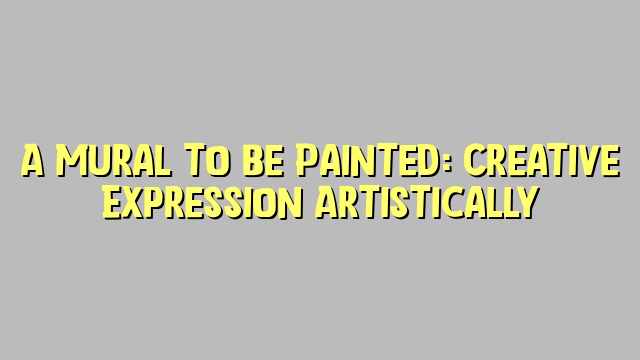
If there’s one thing art does best, it’s provide an outlet for expression. Now, imagine that expression painted boldly on a public wall for the world to see and appreciate. That’s the very essence of what a mural can bring to any environment – something creative and impactful that speaks to the souls of all who view it. Here, we take a closer look at what it takes to create such a masterful piece of art: presenting an artistic mural that provides both visual satisfaction and creative expression.
1. Exploring Creative Expression Through Mural Painting
Mural painting is one of the most vivid and impressive ways to portray an artist’s creativity. Beyond traditional canvas and paper, it can be a transformative tool for expressing thoughts and ideas in an interactive way.
From full-size walls to realistic outdoor scenes, the possibilities of mural painting are truly limitless. Artists can apply their own personal touch to everything, from bold, eye-catching visuals to intricate cultural patterns, to express their ideas. Mural painting gives an artist the opportunity to dive into imagery free from inhibitions with equal possibility for minimalism and maximalism.
- Bring a unique form of storytelling to any space,
- Create engaging and memorable urban landscapes,
- Adapt classic and modern artwork to any environment.
By combining these painting styles with modern digital tools, mural painting allows artists to:
2. Gaining Inspiration and Finding the Perfect Canvas
Your greatest work of art starts with an idea of inspiration. When you have a burning desire to create something, you should consider the possibilities. From an existing canvas or a blank slate, research and explore the wide range of materials that suit your creative vision. Think beyond the conventional to give yourself an edge.
Finding the perfect canvas to express your ideas can be challenging. Look for unconventional sources of inspiration such as everyday materials, online content, and other art forms. Experiment and explore as much as possible. Once you find the ideal surface to work on, focus and channel your energy through the artwork. Unleash your creativity and work hard to transform your imagination into a tangible piece of art.
3. Adding Color to a Blank Palette: Transforming a Mural
Once the blank palette is stretched and secured on a wall, the difficult job of bringing it to life begins. Transforming a common wall into a mural is about more than adding paint. It is about combining several layers, textures and patterns over time to create a single piece of art.
Art can’t be rushed. Taking the time to plan and sketch out the design of a mural helps ensure the end result is exactly what is imagined. The components of mural design include:
- Colors: Incorporate hues, shades, and tints in any order and pattern.
- Lines: Utilize lines to form patterns, leave intentional breaks, and draw focus to important elements.
- Shapes: Change traditional shapes to inject personality, or maintain classic designs.
- Textures: Create dimension with a variety of textures, from sponge painting to chiseled stones.
The key is to blend the elements together for an art piece that is reflective and in harmony. Through color, texture, shape and line, the blank palette eventually becomes an eye-catching mural that is unique.
4. Using a Mural to Make a Meaningful Impact
Mural artwork is a powerful way to bring energy, life and meaning to public spaces, giving individuals and communities the chance to create something they can pass down and feel proud of. Utilizing a mural as a tool offers an inclusive approach to integrating a larger message with a unique style and story. Here are some benefits of using murals as an impactful tool.
- Showcases diversity and culture: Murals provide the opportunity to celebrate and bring life to the cultural identity of a neighborhood or city, and communicate in a visually powerful way.
- Encourages civic engagement: Murals also serve as a way for different individuals and communities to come together and work collaboratively on a project.
- Elevates public spaces: By transforming an underutilized street corner or bland wall, a mural can breathe new life into an area and make it more inviting.
The focus of the message behind a mural should center on creating an atmosphere of positivity, whether it’s about sparking open dialogue or evolving with changes in the neighborhood. Taking a thoughtful approach to a mural’s design, as well as selecting colors and shapes with purpose and careful consideration, heightens its effectiveness. All in all, utilizing murals to make a meaningful impact on a larger scale helps to spread a more harmonious and tolerant message.
This mural is sure to be a sight to behold, a testament to the creativity and expression that can be found in even the simplest of art projects. May it be the perfect backdrop for unique conversations and the start of new traditions.